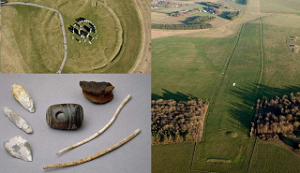
Arquivo para January 26th, 2017
Antropotechnics and Stonehenge
Anthropotechnics is the name given to the idea that it is possible to link  anthropology and its human developments to the development of techniques that influenced civilizational and even structural change in the form of human organization, the term is due to Peter Sloterdijk who attempts to explain current technology processes In modernity.
anthropology and its human developments to the development of techniques that influenced civilizational and even structural change in the form of human organization, the term is due to Peter Sloterdijk who attempts to explain current technology processes In modernity.
Stonehenge is a monument from the Neolithic period, believed to have arisen in a period called by Mesolithic archaeologists between 8500 to 7000 BC (Vatcher and Vatcher, 1973) and has recently been discovered to be part of larger circles (figure 1).
It is not known how the first monuments of stones (post-holes) appeared there, but a reasonable hypothesis is that some already existed and soon others were being brought by a long period of about a thousand years, some coming from very far from regions like Wales.
One possibility studied is that the landscape of the region of Stonehenge in the past may have been especially open, which squeezes to require some technology to transport the enormous stones, there would be a kind of rectangular earthenings (the Greater call of Stonehenge and the smaller one of Cursus) that Allowed the movement of the stones in tree trunks or even in glacial glaciers that allowed the movement of the stones (French, 2012), according to figure 2.
Two stones known as Heel Stone and North Barrow were the earliest components of Stonehenge, but the circular trench with internal and external benches were built in 3000 BC and were brought out of there (Figure 3).
It is possible that features such as the Heel Stone and the low mound known as the North Barrow were early components of Stonehenge, but the earliest known main event was the construction of a circular trench with an inner and outer bank built about 3000 BC And Pearson, 2010). This area closed about 100 meters in diameter, and had two entrances. It was an early form of the henge monument (LAST, 2011).
Inside the benches and about 60 ditches were found several wooden instruments, of stones and some of them that were noticed because they were of copper, like the ones that were called ditches of Aubrey, the people buried there were around of 150 individuals, Being the largest neolithic cemetery (PEARSON, 2012).
A stone (gneiss) and found bone pins associated with cremated human remains in the Aubrey holes at Stonehenge, say that there was a graveyard.
VATCHER, G e VATCHER, M., ‘Excavation of three post-holes in Stonehenge car park’, Wiltshire Archaeological and History Magazine, 68 (1973), 57–63.
FRENCH, C. et al, ‘Durrington Walls to West Amesbury by way of Stonehenge: a major transformation of the Holocene landscape’, Antiquaries Journal, 92 (2012), 1–36.
FIELD, D. and PEARSON, T. World Heritage Site Landscape Project: Stonehenge, Amesbury, Wiltshire Archaeological Survey Report, English Heritage Research Department Report 109-2010 (Swindon, 2010).
LAST, J., Introduction to Heritage Assets: Prehistoric Henges and Circles (English Heritage, 2011).
PARKER, M.; CHAMBERLAIN, A., MARSHALL, M. J., POLLARD, RICHARDS, C. THOMAS, J., TILLEY, C. e WELHAM, K., ‘Who was buried at Stonehenge?’ Antiquity, 83, 2009, 23–39.
PEARSON, M Parker, Stonehenge: Exploring the Greatest Stone Age Mystery (London, 2012), 193.

